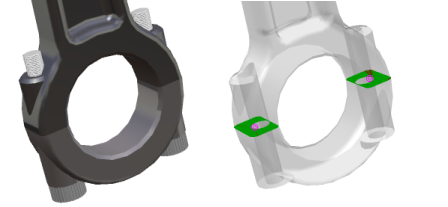About Bonds | ||||
|
| |||
Click Play to watch the video:
A bond consists of two surfaces on two separate assembly components. These two surfaces will remain firmly attached to one another during a simulation, as if they were glued or welded together. The surfaces may stretch, bend, or deform together during the simulation, but they will never move relative to each other. Bonds represent the most basic connection between components, essentially joining two components into a single component at a common interface.
The two surfaces in a bond should be touching in the assembled product. If a bond is defined between two surfaces that have a very slight separation, these surfaces will still behave as if they are bonded together during the simulation. You cannot define bonds between surfaces with anything more than very slight separation. For further explanation, see Requirements for Creating Bonds.
When two surfaces are selected for a bond connection, only the common interface of those surfaces is bonded during the simulation; surface regions that do not overlap are automatically excluded from the bond definition. Consider the two crossing bars in the following image (left). The surfaces selected for the bond connection overhang each other significantly (center). During the simulation only the regions of the surfaces that are touching get bonded (right); the remainder of the surfaces are free to move and deform independently.
Bonds accurately represent simple, permanent connections, such as welds. A bond may also be used to approximately represent simplified connections between two components that are fastened together using other means. For example, if two components are bolted together, a bond can be defined between the contacting surfaces around the bolt; the bolt no longer serves a purpose and can be removed from the assembly for the simulation.